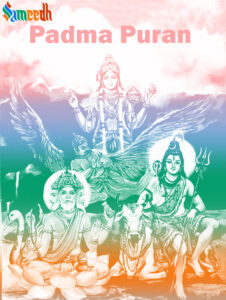The Padma Puran is one of the eighteen Mahāpurāṇs, a genre of ancient Indian scriptures. Like other Purans, it is a vast genre of literature that covers a wide range of topics, including cosmogony, mythology, legends, religious practices, and moral teachings.

The Padma Puran, like many other Purans, is considered to be a product of the ancient oral tradition of storytelling. According to Hindu tradition, the Purans were composed by the sage Vyasa, also known as Vedavyasa or Krishna Dvaipayana Vyasa. Vyasa is credited with compiling and arranging the Vedas and composing the Mahabharat, including the Bhagavad Gita. The Padma Purana is attributed to the sage Vyasa and is named after the lotus (Padma) which is a symbol associated with Lord Brahma, who is often depicted seated on a lotus and includes large sections dedicated to Vishnu, as well as significant sections on Shiv and Shakti.
The Purans are said to have been composed in different epochs, with the primary purpose of preserving and transmitting religious, mythological, and historical knowledge. The Padma Puran, in particular, is attributed to Vyasa and is named after the lotus (Padma), symbolizing purity and divine creation.
The process of composition and transmission of the Purans involves a combination of oral and written traditions. The Purans were passed down through generations orally before being eventually committed to writing. Over time, different recensions and versions of the Purans emerged, leading to variations in content and structure.
The Padma Puran, with its five Khandas (sections), covers a wide range of topics, including cosmology, mythology, religious practices, and moral teachings. Each Khanda is further divided into sections known as Adhyayas. Its diverse content reflects the cultural and religious diversity within Hinduism.
The five Khandas of the Padma Purana are:
- Srishti Khanda (Creation Section): This section deals with the cosmogony and the creation of the universe.
- Bhumi Khanda (Earth Section): It describes the geography of the Earth, various pilgrimage sites, and the importance of performing religious rituals.
- Swarg Khanda (Heaven Section): This section provides details about heaven, celestial beings, and the rewards of virtuous deeds.
- Patal Khanda (Underworld Section): It describes the netherworld, including the various hells and the consequences of sinful actions.
- Uttara Khanda (Final Section): This section includes miscellaneous topics, including legends, genealogies, and discussions on dharm (righteousness) and spiritual knowledge.
The Padma Purana also contains several narratives and stories, including those related to Lord Vishnu, Lord Shiv, Devi (the Divine Mother), and various other deities. It also discusses the importance of pilgrimage, rituals, and the code of conduct for individuals in different stages of life.
Popular Story
A Kṣatriya king. Once this king killed a deer while it was breast-feeding its child and by a curse of the mother-deer Prabhañjan had to live as a tiger for a hundred years.
As the curse takes effect, King Prabhañjan undergoes a profound transformation. Both physically and mentally he was a changed soul. He is reborn as a majestic tiger and forced to roam the dense jungles. All he did was hunting for his survival.
The once-powerful king is now little more than a beast. The brutal truths of the animal kingdom are something he is struggling with. The hurdles he encounters, the interactions he has with other creatures, and the unrelenting passage of time. During this time, he develops a special perspective on life, karma, and the effects of his previous deeds.
When the period of the curse was coming to an end, the tiger heard the advice of a cow called Nandā and got himself transformed into his original form of the king. She imparts information about karma, and dharma. Nanda’s teaching help Prabhajan understand the value of asking for forgiveness and the gravity of showing compassion. She instructs him on how to make a sacrifice and a beg for mercy.
As the hundred-year period of his curse approaches its end. Prabhañjan was now a wiser and humbler soul. He begins to contemplate his return to human form. He embarks on a series of austerities and penances to appease the gods and seek their mercy.
In the end, this led him on a spiritual journey that altered the course of his life. The gods were moved by his sincere efforts and decide to grant him a second chance.
Prabhañjan is restored to his original form as a Kṣatriya king. However, he is no longer the arrogant and reckless monarch he once was. He returns to his kingdom with a transformed heart and a deep sense of remorse for his past actions.
The tale of Prabhajan serves as a powerful metaphor for the concepts of karm, redemption and the transformational potential of regret and remorse. His transformation from a violent hunter to a modest and wise ruler serves as an example of the profound spiritual principles revealed in the Padma Puran.
The story of Prabhajana shows us that decisions we make have an effect and that even the most powerful people can lose support if they deviate from dharma. It also highlights the potential for personal growth and redemption in the face of daunting challenges.
As with other Puranas, the Padma Puran serves not only as a religious scripture but also as a source of cultural and historical information. It has played a significant role in shaping Hindu religious practices, traditions, and mythology.